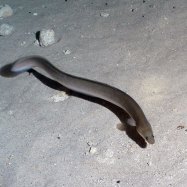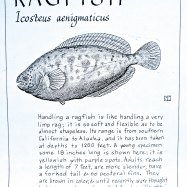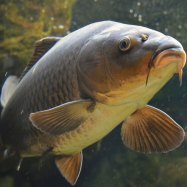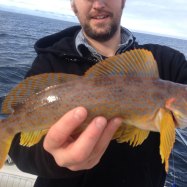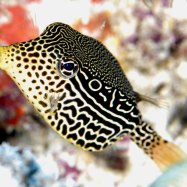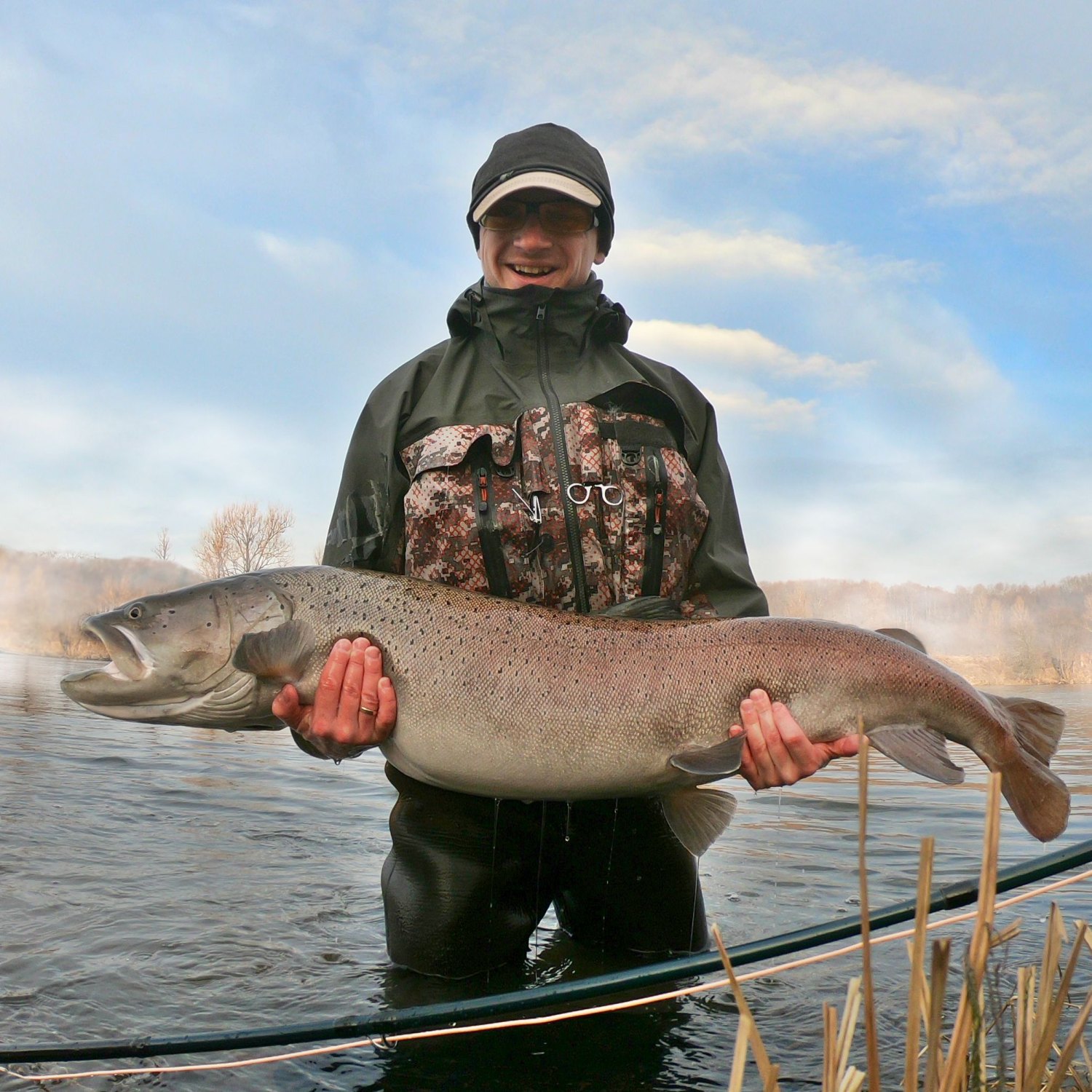
Huchen
Upstream migration during the spring
Did you know that the Huchen fish, also known as the Danube salmon, can live up to 30 years? These migratory fish can be found in several European countries and are known for their annual upstream migration during spring. Look out for them on their way to their spawning grounds! #Huchen #DanubeSalmon #UpstreamMigration #EuropeanFish
Summary of Fish Details:
Common Name: Danube salmon
Habitat: Freshwater rivers
Color: Dark greenish-gray on the back and upper sides, lighter on the belly
The Mighty Danube Salmon - A Jewel of Central and Eastern Europe
The mighty Huchen, also known as the Danube salmon, is a majestic and elusive fish that calls the freshwater rivers of Central and Eastern Europe its home. With its dark greenish-gray color, slender and elongated body, and impressive size of up to 1.5 meters (5 feet), the Huchen is a true jewel of the waters.But aside from its striking appearance, what makes the Huchen a unique and fascinating creature? In this article, we will dive deep into the world of the Danube salmon, exploring its habitat, feeding behaviors, distribution, and more Huchen.
An Introduction to the Huchen
Scientifically known as Hucho hucho, the Huchen belongs to the Salmonidae family, making it a close relative of the well-known salmon and trout. Its common name, Danube salmon, is derived from its preference for the Danube River, one of the longest European rivers.The Huchen is a slow-growing species and can only be found in freshwater rivers, making it a highly sought-after catch for avid fishermen. Its impressive size and strength make it a prized gamefish, making it a source of tourism and income for the countries where it can be found.
Habitat and Feeding Habits of the Huchen
The Huchen is a freshwater fish that can be found in the riffles and deep pools of rivers. These are areas with high oxygen levels and fast-moving water, providing the perfect environment for the fish to thrive. They prefer clear and clean water, making them a good indicator of the health of a river ecosystem.In terms of feeding habits, the Huchen is a carnivore, with its diet consisting mainly of fish such as trout, grayling, and other smaller species. This also includes crustaceans and insects found in and around the rivers Herring. Its elongated body, with a large head and mouth, is perfectly adapted for catching prey in the water.
The Huchen is an ambush predator, meaning it lies in wait for its prey to come within striking distance before attacking. It is a patient hunter, with its dark color providing camouflage in the water, making it difficult for its prey to spot it.
Geographic Distribution and Country of Origin
The Huchen is a native species of Central and Eastern Europe, with its natural distribution reaching countries such as Austria, Croatia, Germany, Hungary, Romania, Serbia, Slovakia, and Slovenia. However, due to its popularity as a gamefish, it has been introduced to other European countries, including Switzerland and Italy.This distribution is closely tied to the river systems of these countries, with the Danube River being the most well-known habitat for the Huchen. However, it can also be found in other river basins, including the Drina, Sava, and Tisza rivers.
Appearance and Physical Characteristics
The Huchen has a dark greenish-gray color on its back and upper sides, with a lighter color on its belly. This provides camouflage in the water, helping it to blend in with its surroundings. Its slender and elongated body is covered in small scales, giving it a smooth and sleek appearance.One of the most striking physical features of the Huchen is its large head and mouth, making it instantly recognizable. Its mouth is filled with sharp teeth, which it uses to catch and hold onto its prey. Its powerful fins also aid in maneuvering through the fast-moving water.
Size, Age, and Reproduction
The Huchen is a slow-growing species, with individuals taking 8-10 years to reach maturity. The average length of a mature Huchen is about 1 meter, but they can grow up to an impressive 1.5 meters (5 feet) in length. Its size is a result of its long lifespan, with the Huchen being known to live up to 30 years in the wild.Like most salmonid species, the Huchen is a sexual reproducer, with a unique annual migration to spawning grounds. During the spring, adult Huchen make their way upstream, where they lay their eggs and spawn. After spawning, the adults make their way back downstream to their feeding habitats.
Threats and Conservation Efforts
The Huchen is considered an endangered species in many of its natural habitats, primarily due to overfishing and habitat destruction. The construction of dams and pollution of rivers have greatly affected the Huchen's ability to migrate and spawn, leading to a decline in its numbers.However, there have been efforts to protect and conserve the Huchen, with organizations and governments implementing measures to restore and protect its natural habitats. These efforts include the removal of dams, stocking of hatchery-reared Huchen, and strict regulations on fishing.
The Huchen and Human Interaction
The Huchen has a long and impressive history of interaction with humans, dating back to ancient times. In Austria, the Huchen has been considered a symbol of the Danube River and is depicted on the country's 1000 Schilling banknote. It has also been a popular subject in art, literature, and folklore.As mentioned earlier, the Huchen is also a prized gamefish, attracting many anglers to the rivers in search of a catch. Its impressive size and strength make it a challenging and rewarding fish to catch, making it a popular recreational activity for locals and tourists alike.
In Conclusion
The Huchen, or Danube salmon, is a fascinating and wonderful creature that has captured the hearts and minds of many. Its natural habitat, feeding habits, impressive size and lifespan, and its interactions with humans make it a unique and valuable species.However, conservation efforts must continue to protect and preserve this incredible fish. Through education and awareness, we can ensure that the Huchen remains a jewel of Central and Eastern Europe for generations to come. So, the next time you find yourself near the Danube River, keep an eye out for the mighty Huchen, a true symbol of the beauty and diversity of our natural world.

Huchen
Fish Details Huchen - Scientific Name: Huchen
- Category: Fish H
- Scientific Name: Huchen
- Common Name: Danube salmon
- Habitat: Freshwater rivers
- Feeding Habitat: Riffles and deep pools
- Feeding Method: Carnivorous
- Geographic Distribution: Central and Eastern Europe
- Country Of Origin: Austria, Croatia, Germany, Hungary, Romania, Serbia, Slovakia, Slovenia
- Color: Dark greenish-gray on the back and upper sides, lighter on the belly
- Body Shape: Slender and elongated body with a large head and mouth
- Length: Up to 1.5 meters (5 feet)
- Adult Size: Up to 1.5 meters (5 feet)
- Age: Can live up to 30 years
- Reproduction: Sexual
- Reproduction Behavior: Annual migration to spawning grounds
- Migration Pattern: Upstream migration during the spring
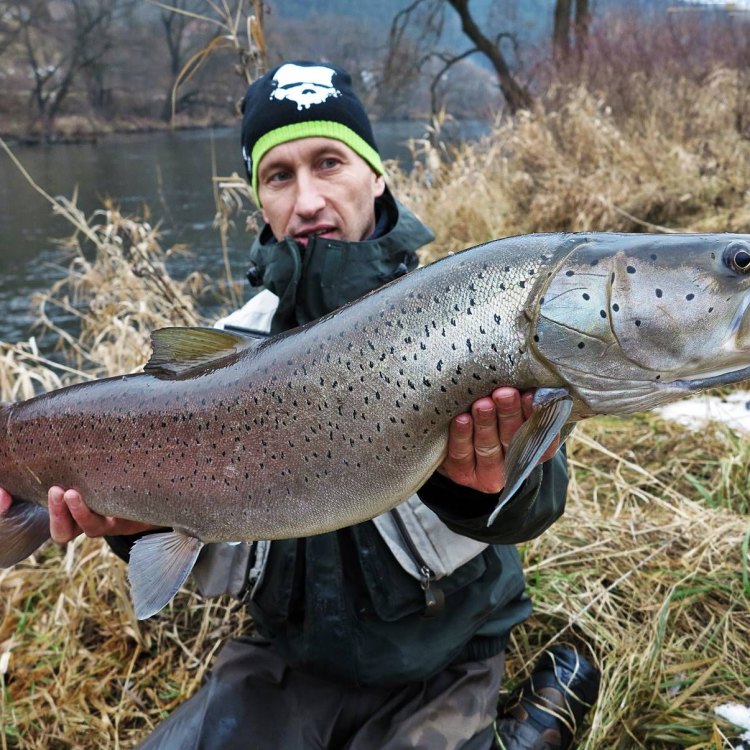
Danube salmon
- Social Group: Solitary
- Behavior: Predatory
- Diet: Mainly feeds on fish, but also eats crustaceans, insects, and mollusks
- Predators: Humans, birds of prey, larger fish
- Prey: Fish, crustaceans, insects, mollusks
- Environmental Threats: Habitat degradation, pollution, overfishing
- Conservation Status: Endangered
- Special Features: Large size, powerful and fast-swimming
- Interesting Facts: Huchen is often referred to as the king of rivers due to its size and strength
- Reproduction Period: Spring
- Nesting Habit: Gravel or rocky substrate in clean, fast-flowing water
- Lifespan: Up to 30 years
- Habitat Threats: Dam construction, water pollution, habitat fragmentation
- Population Trends: Declining
- Habitats Affected: Freshwater rivers
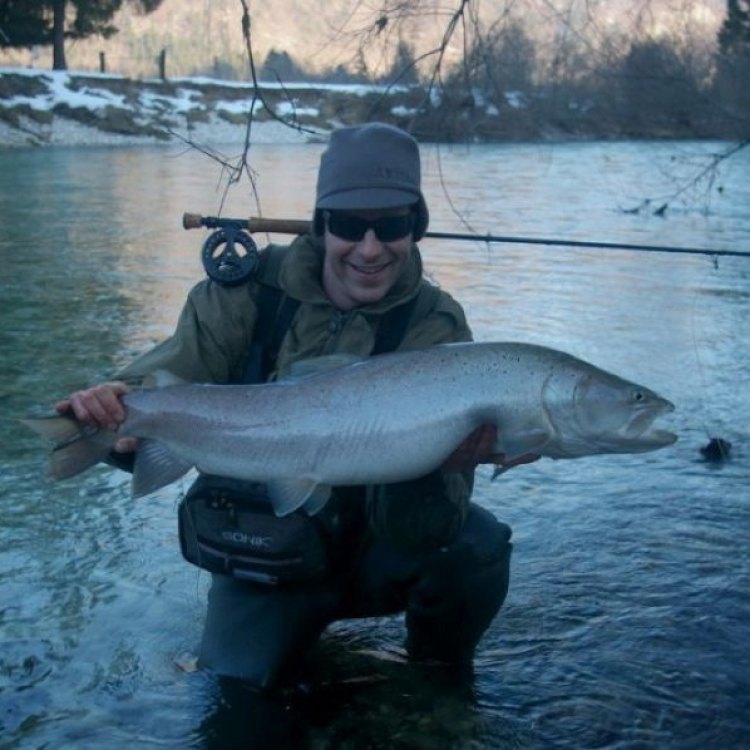
Huchen
The Majestic Huchen: The Endangered King of Rivers
Nestled in the freshwater rivers of Europe lies a majestic fish species known as the Huchen. With its imposing size, powerful features, and solitary behavior, it is often referred to as the "king of rivers". However, this noble fish is facing numerous threats that have led to its endangered status. In this article, we will dive into the unique features of the Huchen and explore the challenges it faces in its natural habitat RadioDouRosul.com.The Huchen, also known as Danube salmon, is a species of freshwater fish from the family Salmonidae. It can grow up to 1.5 meters in length and weigh up to 50 kilograms, making it one of the largest species in the Salmonidae family. Its physical appearance is similar to that of a brown trout, but with distinct features such as a broad, flat head and a large mouth with strong teeth. The color of its scales can range from silver-gray to reddish-brown, depending on its age and location.
One of the most unique features of the Huchen is its powerful and fast-swimming abilities. It is a solitary fish that prefers to hunt alone, and its predatory behavior is the key to its survival. The Huchen mainly feeds on fish, making it a vital part of the river's food chain. However, it also consumes crustaceans, insects, and mollusks, making its diet diverse and flexible Halibut. This adaptability to different food sources enables the Huchen to thrive in various river ecosystems, making it a vital species in maintaining the balance of the aquatic food web.
Despite being a skilled hunter, the Huchen also has its share of predators. Humans, especially anglers, are the primary threat to this species. Due to its large size and strength, the Huchen is an attractive target for sportfishing. As a result, overfishing has significantly reduced its population. Moreover, birds of prey and larger fish also pose a significant risk to the Huchen, especially during its juvenile stage.
Apart from human activities, the Huchen also faces numerous environmental threats. Habitat degradation, pollution, and overfishing have all contributed to the decline of this species. The construction of dams and pollution from industrial and agricultural activities have greatly impacted the Huchen's natural habitat. Dams block their migratory routes, making it challenging for them to reach their spawning grounds. Pollution, such as chemical waste and plastic debris, also affects the quality of the water, making it unsuitable for the Huchen's survival. Furthermore, overfishing has caused a decline in the Huchen population, especially in countries where it is commercially targeted.
These threats have led to the Huchen's conservation status as endangered, according to the International Union for Conservation of Nature (IUCN). It is estimated that the Huchen population has declined by more than 50% in the last 10 years, and this trend is continuing. With their limited distribution and slow reproductive rate, the Huchen is struggling to rebound from these threats.
Huchen reproduction period occurs in the spring, making it a critically vulnerable time for the species. During this time, they migrate to suitable spawning grounds in clean, fast-flowing water. They lay their eggs on gravel or rocky substrate, and the males fertilize them. Once the eggs hatch, the young Huchen remain in the rivers for around 2 to 3 years before heading to the sea. This delayed sexual maturation, with females maturing at 5-10 years old and males at 3-6 years old, makes the Huchen slow to reproduce. Furthermore, their long lifespan of up to 30 years means that a single Huchen's reproductive output is crucial for the species' survival. Any disruption to their spawning grounds can have a significant impact on their future generations, leading to a further decline in their population.
To protect the Huchen, conservation efforts are crucial. Some countries such as Austria, Germany, and Slovenia have established conservation programs to monitor and protect the species. These programs focus on restoring the Huchen's habitats by removing barriers and managing water quality. Dams are being modified to allow for fish passage, and pollution is being regulated to ensure the water is suitable for the Huchen's survival. Additionally, awareness campaigns are being carried out to educate the public on the value and importance of the Huchen in their ecosystem.
The decline of the Huchen population has also sparked efforts to breed them in captivity. These individuals are then released into the wild to boost the population. While this method has shown some success, it is not a long-term solution. Captive breeding can lead to a decrease in genetic diversity, which is essential for the species' survival and adaptation to changing environments.
In addition to conservation efforts, it is crucial to address the root causes of the Huchen's decline. This involves implementing sustainable fishing practices, controlling pollution, and managing dams and other infrastructure that disrupt their habitat. Collaboration between governments, conservation organizations, and local communities is essential in protecting this endangered species.
The decline of the Huchen population also has a significant ecological impact. These fish play a vital role in maintaining the health and balance of freshwater ecosystems. Their predatory behavior helps control the population of their prey, preventing them from overpopulating and causing imbalances in the food web. Moreover, the Huchen's migratory behavior also plays a crucial role in nutrient transport, as they transfer nutrients from the sea to their spawning grounds in rivers, enriching the surrounding environment.
In conclusion, the Huchen is a unique and vital species in European freshwater rivers. Its large size, powerful features, and solitary behavior have earned it the title of "king of rivers". However, this majestic fish is facing numerous threats, including habitat degradation, pollution, and overfishing, leading to its endangered status. With collaborative efforts and sustainable practices, we can help protect the Huchen and ensure that it continues to thrive in its natural habitat as the king of rivers.
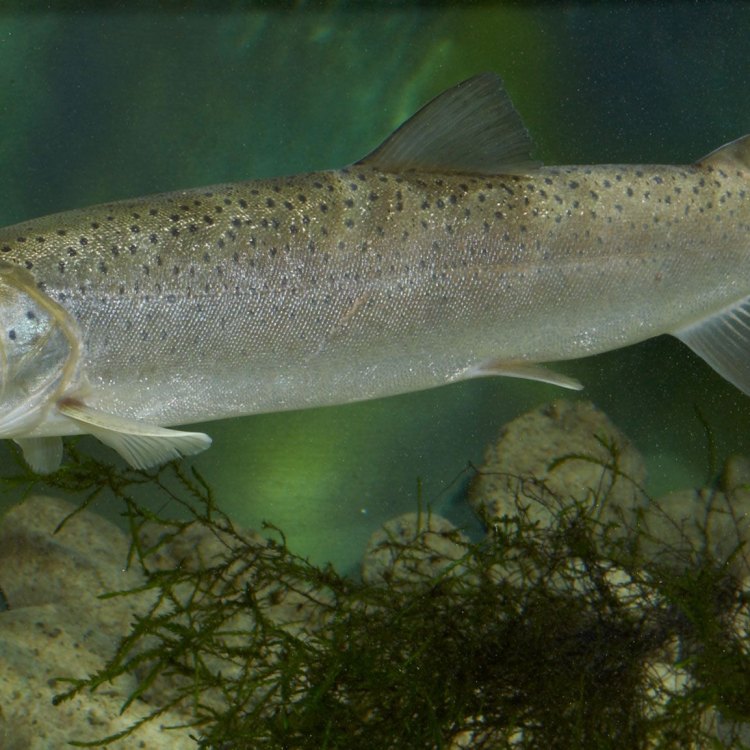
The Mighty Danube Salmon - A Jewel of Central and Eastern Europe
Disclaimer: The content provided is for informational purposes only. We cannot guarantee the accuracy of the information on this page 100%. All information provided here may change without prior notice.

